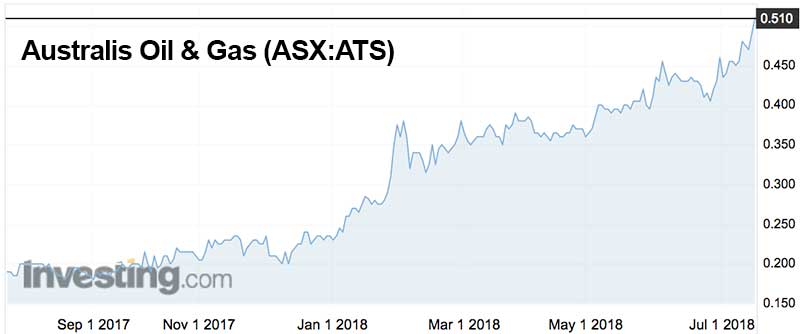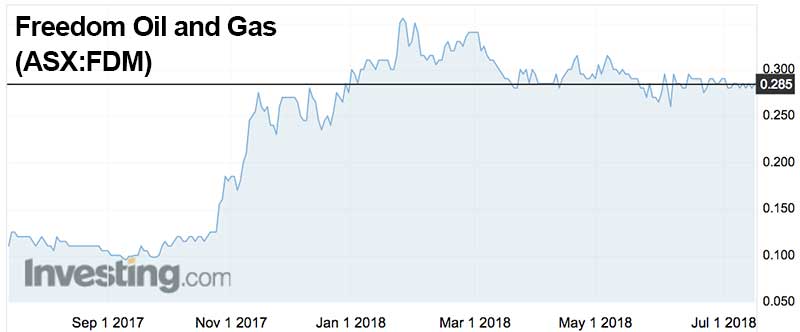These Aussie small cap oil stocks are blazing a trail in the US

Pic: Matthias Kulka / The Image Bank via Getty Images
BHP’s imminent exit from onshore oil production in the US will finalise a disastrous foray for the big Australian resources company.
But it also masks the fact that a fleet of small and largely forgotten Australian oil stocks are doing rather well in the US — the home of oil.
ASX-listed stocks such as Australis, Sundance, Byron, Otto, 88Energy and the very interesting Freedom Oil & Gas have all made progress with their US assets, and seen their share prices rise despite a low profile with Australian investors.
Australis (ASX:ATS) in particular is edging closer to a significant step up, though not necessarily in terms of how much oil and gas it might be producing but from an outright sale in a market which has grown hungry for energy assets.
Regular readers of Stockhead will remember that the plans of Australis were examined here in a mid-May story when the stock was trading at 39.5c — on its way to a high last week of 50c.
Those plans appear to be crystallising. Australis managing director Ian Lusted said last week the company’s aim was not to be the biggest Australian-based US oil and gas producer — rather it was “to generate shareholder value; that may mean a total exit, that may mean a partial exit”.

Australis Oil & Gas shares over the past yearIt’s a plan that appears to be working thanks to the recovery in the oil price and the promise of strong production from the company’s plum asset, the Tuscaloosa Marine Shale just inland from the Gulf of Mexico coast.
What is shale oil
Conventional oil is generally found in porous rocks that readily release most of their oil and gas in reservoirs (or traps).
Shale, on the other hand, is what the industry calls unconventional oil because it’s a tight rock that often needs to be fractured (fracced) to force the release of oil and gas.
For most of the 20th century shale was ignored by explorers because they didnt have the technology to “squeeze” out the oil and gas in its pores.
That changed with rock-fraccing technology designed to break shale, and the invention of directional drilling that saw vertical drill holes turned sideways to track a layer of oil-rich shale (and other unconventional rock types). Some holes travel more than 5km laterally.
A true “game changing” suite of technologies has now pened up vast areas of oil-rich acreage once considered uneconomic, in both area and depth.
Sundance and Freedom
Sundance Energy (ASX:SEA) is another successful Australian player in the onshore US shale-oil game but is also feeling the effects of rising costs as Rachel Williamson explained in her May 18 story.
The focus of Sundance is the Eagle Ford shale in southern Texas.
It’s in the same area selected by Freedom Oil and Gas (ASX:FDM), an Australian explorer that has kept a low profile but is led by the man who did more than most in taking BHP into US shale back in 2011.
Mike Yeager, a Texan oilman with a career that included senior positions with Exxon Mobil, left BHP in 2013 to join an oil minnow called Maverick Drilling and Exploration — which he renamed Freedom Oil and Gas.

Obviously a true believer in US shale, Yeager has directed Freedom into a large tenement position in Dimmit County of south-west Texas which is regarded as being a liquids-rich location.
While impossible to accurately compare Freedom’s small shale holding with BHP’s position it will be interesting to see how Yeager’s comeback corporate vehicle performs.
If share price is a valid tool he’s doing alright so far with Freedom more than doubling over the past 10 months, with a rise from 12c to recent sales at 28c.
Byron, Otto and 88Energy
Byron Energy (ASX:BYE) and Otto Energy (ASX:EOL) are both exploring in waters off the southern US coast. Their latest project is a joint venture to drill the Bivouac Peak East prospect, starting in August.
Byron’s share price has doubled from 14c to 28c since late last year, but it is down on a peak price of 45c reached in March. Otto is up from 3c to 6c over the past 12 months, but down on its May high of 8c.
88 Energy (ASX:88E), which is listed on both the ASX and AIM (the junior London market), is exploring in the oil world’s equivalent of elephant country — the North Slope of Alaska — but with a difference.
While the North Slope is a prolific conventional oil and gas province, 88Energy is looking for unconventional (shale) reservoirs. While successful in part its latest well, Icewine No.2 was suspended earlier this month, leading to a sell-off which has seen the stock fall from 5c early last month to recent sales at 2c.
- Subscribe to our daily newsletter
- Bookmark this link for small cap news
- Join our small cap Facebook group
- Follow us on Facebook or Twitter
Despite 88 Energy’s setback with its Icewine project, the company has been attracted to the US by the same factors which first lured BHP — abundant oil and gas in the ground (whether trapped in shale or conventional reservoirs), a big domestic market, vast pipeline network and a skilled workforce.
What killed BHP’s ambitions (and the early enthusiasm of people like Yeager) was that it moved too early and paid too much in a market fueled by sky-high oil and gas prices — and then found that much of the ground it had acquired was rich in gas and poor in oil.
Times change and the small Australians have timed their entry well, getting in when prices were low, and riding oil and gas prices up while also enjoying a boost from the pro-development policies of President Trump.
The net result is that while the choice of small oil stocks active in Australia is limited by the country’s geology and the anti-development government policies of most State Governments, there is a way into small and ambitious Australian oil and gas stocks and that’s by looking across the Pacific.
UNLOCK INSIGHTS
Discover the untold stories of emerging ASX stocks.
Daily news and expert analysis, it's free to subscribe.
By proceeding, you confirm you understand that we handle personal information in accordance with our Privacy Policy.








